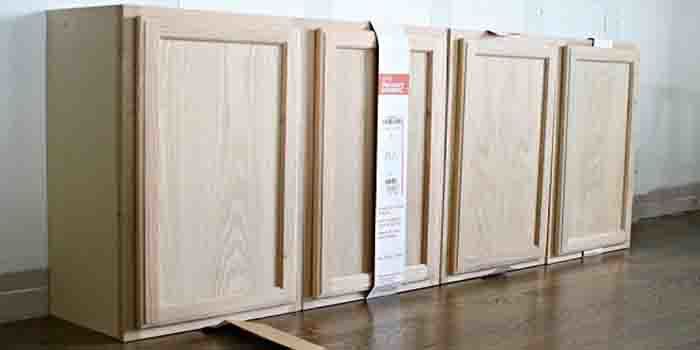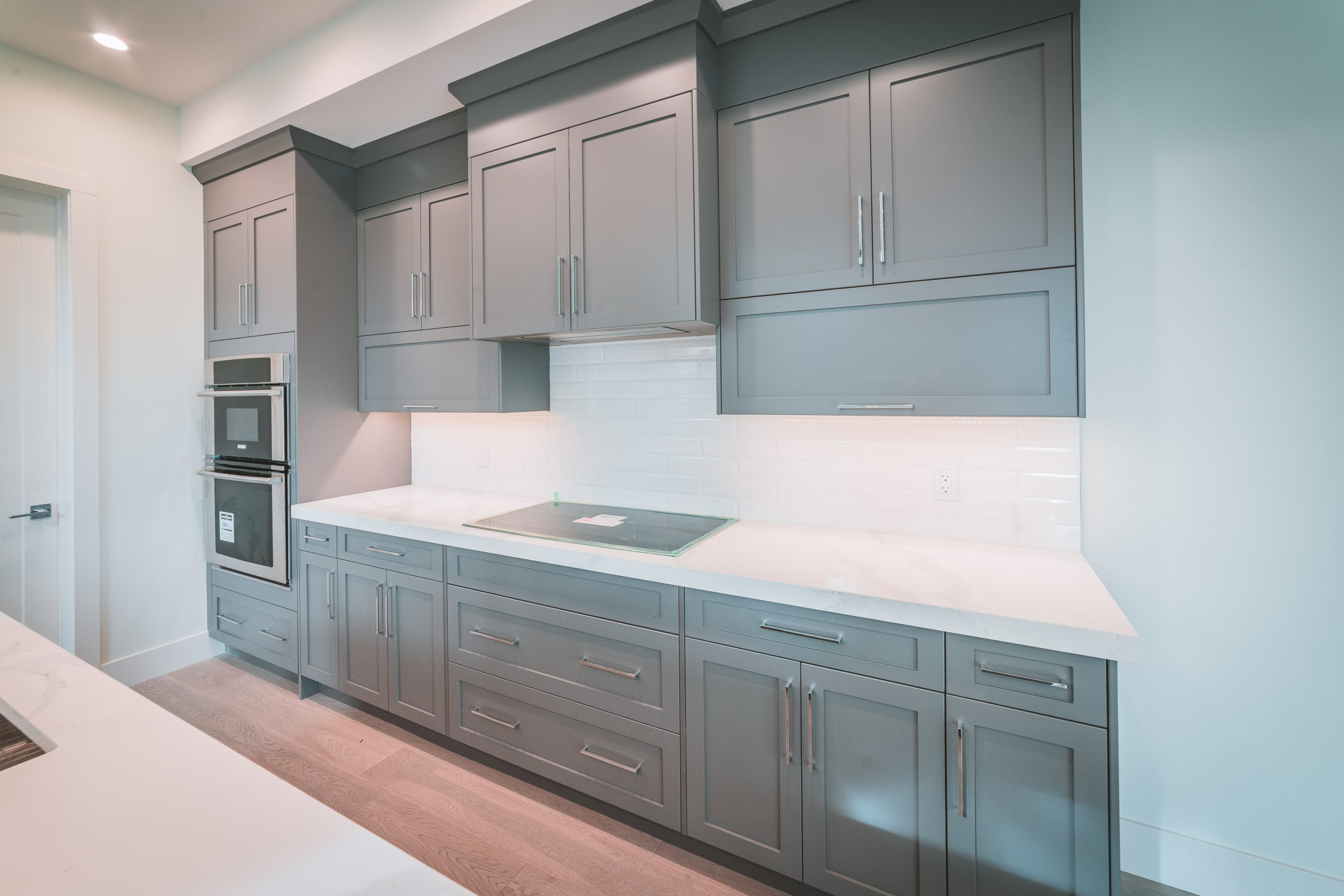Understanding Composite Wood Cabinets

Composite wood cabinets have gained popularity in recent years, offering a blend of affordability, durability, and design versatility. They are crafted using engineered wood products, such as particleboard, plywood, and medium-density fiberboard (MDF), which are manufactured by combining wood fibers with adhesives and resins. This process creates a stable and consistent material suitable for cabinet construction.
Construction Process and Materials
Composite wood cabinets are built using a combination of different engineered wood products, each offering specific advantages.
- Particleboard: Composed of wood chips or sawdust bonded together with resin. Particleboard is known for its affordability and consistency but can be susceptible to moisture damage.
- Plywood: Consists of thin layers of wood veneer glued together with alternating grain directions. Plywood is strong, stable, and resists warping, making it ideal for cabinet construction.
- Medium-Density Fiberboard (MDF): Made from wood fibers that are broken down, refined, and then bonded with resin under high pressure and heat. MDF offers a smooth, consistent surface, making it suitable for intricate designs and painted finishes.
Advantages and Disadvantages
Composite wood cabinets offer a compelling alternative to traditional wood cabinets.
Advantages
- Affordability: Composite wood is generally less expensive than solid wood, making it a budget-friendly option for kitchen and bathroom renovations.
- Consistency: Engineered wood products offer a consistent density and grain pattern, reducing the variability inherent in natural wood.
- Design Versatility: The smooth surface of composite wood allows for various finishes, including painting, staining, and laminating, providing ample design possibilities.
Disadvantages
- Moisture Sensitivity: Some composite wood products, particularly particleboard, are susceptible to moisture damage. It’s essential to use moisture-resistant materials in areas like bathrooms and kitchens.
- Durability: Composite wood can be less durable than solid wood, especially when exposed to heavy impacts. It’s important to handle composite wood cabinets with care.
- Formaldehyde Emissions: Some composite wood products may contain formaldehyde, a volatile organic compound that can emit fumes. Look for cabinets made with low-emission or formaldehyde-free materials.
Durability and Longevity
Composite wood cabinets can offer significant durability and longevity when properly cared for.
- Moisture Resistance: Cabinets used in humid environments should be made from moisture-resistant materials, such as plywood or MDF treated with a moisture-resistant finish.
- Scratch Resistance: Composite wood cabinets are generally more scratch-resistant than solid wood, especially when finished with a durable coating like laminate or paint.
- Longevity: With proper care and maintenance, composite wood cabinets can last for many years. Regular cleaning and avoiding harsh chemicals will help preserve their appearance and longevity.
Types of Composite Wood
The following table compares the characteristics of different composite wood types used in cabinet construction:
| Type | Composition | Advantages | Disadvantages |
|---|---|---|---|
| Particleboard | Wood chips or sawdust bonded with resin | Affordable, consistent | Susceptible to moisture damage, less durable than other types |
| Plywood | Thin layers of wood veneer glued together with alternating grain directions | Strong, stable, resists warping | More expensive than particleboard |
| Medium-Density Fiberboard (MDF) | Wood fibers broken down, refined, and bonded with resin | Smooth, consistent surface, ideal for intricate designs | Can be prone to chipping or denting, may emit formaldehyde |
Painting Composite Wood Cabinets

Painting composite wood cabinets can be a great way to refresh your kitchen or bathroom. While it may seem daunting, it’s a project that can be tackled with the right preparation, materials, and techniques. This guide will walk you through the process, from choosing the right paint to achieving a professional-looking finish.
Surface Preparation
Proper surface preparation is crucial for a successful paint job. Composite wood cabinets, often made from MDF or particleboard, require special attention due to their porous nature. Here’s a step-by-step guide for prepping your cabinets:
- Clean the Cabinets: Start by thoroughly cleaning the cabinets with a degreaser or a solution of warm water and dish soap. Remove any grease, dirt, or grime that could interfere with the paint’s adhesion.
- Sand the Surfaces: Lightly sand the cabinet surfaces with 120-grit sandpaper to create a smooth, even surface. This will help the primer and paint adhere better.
- Fill Gaps and Cracks: Use wood filler to fill any gaps, cracks, or imperfections in the cabinet surfaces. Allow the filler to dry completely before sanding it smooth.
- Prime the Cabinets: Apply a primer specifically designed for composite wood. This will help the paint adhere properly and prevent the wood from absorbing the paint, leading to uneven color and texture.
Paint Selection
Choosing the right paint is essential for achieving a durable and long-lasting finish. Consider these factors when selecting paint for your composite wood cabinets:
- Adhesion: Look for paints that are specifically formulated for adhesion to composite wood. These paints will bond better to the surface and prevent peeling or chipping.
- Durability: Opt for paints with good durability, especially if the cabinets are in a high-traffic area. Choose paints that are resistant to scratches, stains, and moisture.
- Finish: Choose a finish that complements your style and the overall design of your kitchen or bathroom. Options include matte, satin, semi-gloss, and gloss.
Paint Application
Once you have prepped your cabinets and selected the right paint, you’re ready to start painting. Here’s how to apply paint to your composite wood cabinets:
- Apply Paint in Thin Coats: Apply thin, even coats of paint using a high-quality paintbrush or roller. Avoid overloading the brush or roller, as this can lead to drips and runs.
- Let Each Coat Dry Completely: Allow each coat of paint to dry completely before applying the next coat. This will ensure a smooth and even finish.
- Sand Between Coats: Lightly sand the surface between coats with 220-grit sandpaper to create a smooth transition between coats. This will help create a more professional-looking finish.
Finishing Techniques
Here are some finishing techniques to help you achieve a professional-looking paint job on your composite wood cabinets:
- Use Painter’s Tape: Use painter’s tape to protect areas that you don’t want to paint, such as countertops, walls, or hardware.
- Clean Up as You Go: Clean up any spills or drips immediately to prevent them from drying and becoming difficult to remove.
- Apply Multiple Thin Coats: Applying multiple thin coats is better than applying one thick coat. This will help create a smoother and more even finish.
- Let the Paint Cure Completely: Allow the paint to cure completely before using the cabinets. This will ensure that the paint is fully hardened and resistant to scratches and stains.
Styling and Design Considerations

Painting composite wood cabinets opens a world of possibilities for transforming the aesthetic of your kitchen or bathroom. Choosing the right paint color, finish, and hardware can elevate the overall look and feel of your space, aligning perfectly with your desired style.
Paint Colors and Finishes, Painting composite wood cabinets
Selecting the right paint color and finish is crucial for achieving the desired aesthetic for your painted composite wood cabinets.
- Modern Styles: Modern kitchens and bathrooms often favor clean lines, minimalist designs, and a neutral color palette. Popular paint colors for modern cabinets include white, gray, black, and muted shades of blue or green. High-gloss finishes create a sleek and reflective surface, while matte or satin finishes offer a softer, more understated look.
- Traditional Styles: Traditional spaces often embrace warm and inviting tones, intricate details, and a sense of history. Consider rich colors like cream, beige, brown, or deep blues for traditional cabinets. Distressed finishes, achieved by applying a glaze or using a technique that creates an aged look, can add a touch of character and authenticity to traditional cabinets.
Hardware Selection
Hardware plays a vital role in shaping the overall aesthetic of painted composite wood cabinets.
- Modern Styles: Modern kitchens and bathrooms often feature sleek, minimalist hardware with clean lines. Brushed nickel, stainless steel, or black matte finishes are popular choices for modern cabinets. Consider pulls with simple geometric shapes or bar pulls for a contemporary look.
- Traditional Styles: Traditional kitchens and bathrooms often embrace more ornate hardware with intricate details. Polished brass, oil-rubbed bronze, or antique nickel finishes are popular choices for traditional cabinets. Knobs or pulls with decorative accents, such as floral patterns or scrollwork, can add a touch of elegance to traditional cabinets.
Painting composite wood cabinets can be a great way to refresh your kitchen, but before you start, it’s essential to prep the surfaces properly. This includes cleaning the cabinets thoroughly, which is especially important if they’re older. You can find a comprehensive guide on how to clean old wood cabinet doors , ensuring they’re free of grime and grease before you apply paint.
Once your cabinets are clean, you can move on to sanding and priming, setting the stage for a beautiful and long-lasting finish.
Painting composite wood cabinets can be a great way to refresh your kitchen or bathroom. You can achieve a modern look or a more traditional feel, all while saving money compared to replacing the cabinets entirely. But before you start painting, it’s important to consider the type of composite wood used.
You might wonder, can you paint over fake wood cabinets ? The answer is often yes, but you’ll need to prepare the surface properly to ensure a smooth and durable finish. Once you’ve addressed the compatibility issue, you can unleash your creativity and transform your cabinets into a stunning focal point in your home.
